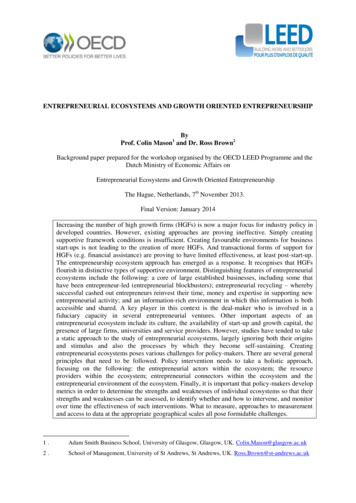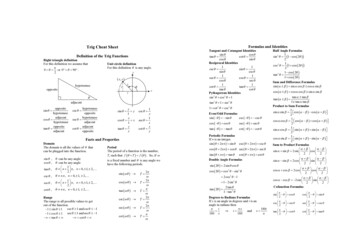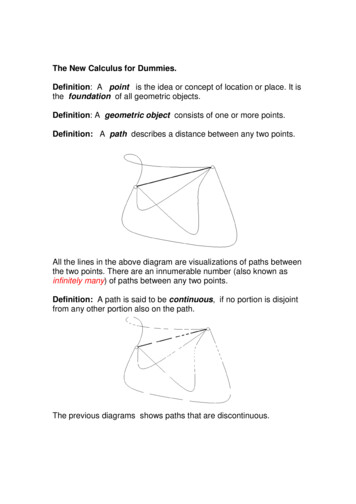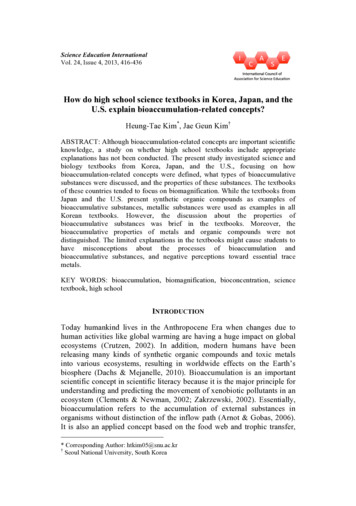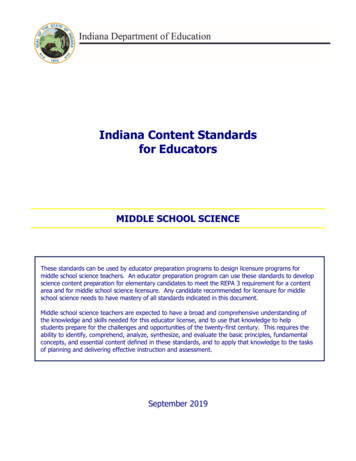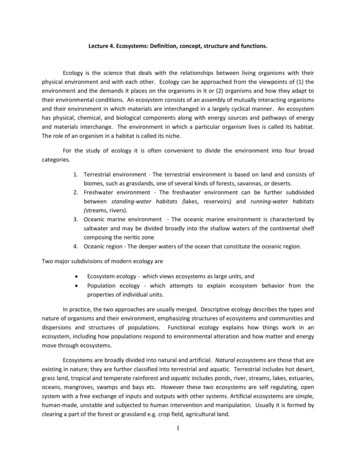
Transcription
Lecture 4. Ecosystems: Definition, concept, structure and functions.Ecology is the science that deals with the relationships between living organisms with theirphysical environment and with each other. Ecology can be approached from the viewpoints of (1) theenvironment and the demands it places on the organisms in it or (2) organisms and how they adapt totheir environmental conditions. An ecosystem consists of an assembly of mutually interacting organismsand their environment in which materials are interchanged in a largely cyclical manner. An ecosystemhas physical, chemical, and biological components along with energy sources and pathways of energyand materials interchange. The environment in which a particular organism lives is called its habitat.The role of an organism in a habitat is called its niche.For the study of ecology it is often convenient to divide the environment into four broadcategories.1. Terrestrial environment - The terrestrial environment is based on land and consists ofbiomes, such as grasslands, one of several kinds of forests, savannas, or deserts.2. Freshwater environment - The freshwater environment can be further subdividedbetween standing-water habitats (lakes, reservoirs) and running-water habitats(streams, rivers).3. Oceanic marine environment - The oceanic marine environment is characterized bysaltwater and may be divided broadly into the shallow waters of the continental shelfcomposing the neritic zone4. Oceanic region - The deeper waters of the ocean that constitute the oceanic region.Two major subdivisions of modern ecology are Ecosystem ecology - which views ecosystems as large units, andPopulation ecology - which attempts to explain ecosystem behavior from theproperties of individual units.In practice, the two approaches are usually merged. Descriptive ecology describes the types andnature of organisms and their environment, emphasizing structures of ecosystems and communities anddispersions and structures of populations. Functional ecology explains how things work in anecosystem, including how populations respond to environmental alteration and how matter and energymove through ecosystems.Ecosystems are broadly divided into natural and artificial. Natural ecosystems are those that areexisting in nature; they are further classified into terrestrial and aquatic. Terrestrial includes hot desert,grass land, tropical and temperate rainforest and aquatic includes ponds, river, streams, lakes, estuaries,oceans, mangroves, swamps and bays etc. However these two ecosystems are self regulating, opensystem with a free exchange of inputs and outputs with other systems. Artificial ecosystems are simple,human-made, unstable and subjected to human intervention and manipulation. Usually it is formed byclearing a part of the forest or grassland e.g. crop field, agricultural land.1
Structure and Function of an ecosystemAn ecosystem has two components the biotic components consisting of living things, and theabiotic portion, consisting of elements that are not alive. The non living constituents are said to includethe following category, habitat, gases, solar radiation, temperature, moisture and inorganic and organicnutrients. The living organisms may be sub divided into producers, consumers and decomposers. AbioticComponents include basic inorganic and organic components of the environment or habitat of theorganism. The inorganic components of an ecosystem are carbon dioxide, water nitrogen, calciumphosphate all of which are involved in matter cycle (biogeochemical cycles). The organic components ofan ecosystem are proteins, carbohydrates, lipids and amino acids, all of which are synthesized by thebiota (flora and fauna) of an ecosystem and are reached to ecosystem as their wastes, dead remains etc.the climate 'microclimate' temperature, light soil etc. are abiotic components of the ecosystems.Functions of an EcosytemEcosystem function is the capacity of natural processes and components to provide goods andservices that satisfy human needs, either directly or indirectly. Ecosystem functions are subset ofecological processes and ecosystem structures. Each function is the result of the natural processes ofthe total ecological sub-system of which it is a part. Natural processes, in turn, are the result of complexinteractions between biotic (living organisms) and abiotic (chemical and physical) components ofecosystems through the universal driving forces of matter and energy. There are four primary groups ofecosystem functions (1) regulatory functions, (2) habitat functions, (3) production functions and (4)information functions. This grouping concerns all ecosystems, not only for forests.General characterization of ecosystem functions are:(1) Regulatory functions: this group of functions relates to the capacity of natural and semi-naturalecosystems to regulate essential ecological processes and life support systems through bio-geochemicalcycles and other biospheric processes. In addition to maintaining the ecosystem (and biosphere health),these regulatory functions provide many services that have direct and indirect benefits to humans (i.e.,clean air, water and soil, and biological control services).(2) Habitat functions: natural ecosystems provide refuge and a reproduction habitat to wild plants andanimals and thereby contribute to the (in situ) conservation of biological and genetic diversity and theevolutionary process.(3) Production functions: Photosynthesis and nutrient uptake by autotrophs converts energy, carbondioxide, water and nutrients into a wide variety of carbohydrate structures which are then used bysecondary producers to create an even larger variety of living biomass. This broad diversity incarbohydrate structures provides many ecosystem goods for human consumption, ranging from foodand raw materials to energy resources and genetic material.(4) Information functions: Since most of human evolution took place within the context of anundomesticated habitat, natural ecosystems contribute to the maintenance of human health by2
providing opportunities for reflection, spiritual enrichment, cognitive development, recreation andaesthetic experience.Components of an ecosystem: Complete ecosystem consists of four basic components such asproducers, consumers, decomposers and abiotic components e.g. Pond. If anyone of these fourcomponents are lacking, then it is grouped under incomplete ecosystem e.g. Ocean depth or a cave.Productivity in the Environment: The productivity of an ecosystem is the rate at which solarenergy is fixed by the vegetation of the ecosystem; it is further classified into primary productivity,secondary productivity and net productivity.Primary productivity refers to the rate at which radiant energy is stored by photosynthetic andchemosynthetic activity of producers; it is further distinguished as gross primary productivity (GPP) andnet primary productivity (NPP). It is expressed in terms of weight (g/m2/yr) or energy (kcal/m2).Secondary productivity refers to the rates of energy storage at consumer levels.An understanding of ecology is essential in the management of modern industrialized societiesin ways that are compatible with environmental preservation and enhancement. The branch of ecologythat deals with predicting the impacts of technology and development and making recommendationssuch that these activities will have minimum adverse impacts, or even positive impacts, on ecosystemsmay be termed as Applied Ecology. It is a multidisciplinary approach .Interactions among living organisms are grouped into two major groups viz., Positive interactionsNegative interactionsI. Positive interactionsHere the populations help one another, the interaction being either one way or reciprocal.These include (i) Commensalism, (ii) Proto co-operation and (iii) mutualism.1. CommensalismIn this one species derives the benefits while the other is unaffected.Eg. (i) Cellulolytic fungi produce a number of organic acids from cellulose which serve as carbon sourcesfor non-cellulolytic bacteria and fungi.(ii) Growth factors are synthesised by certain microorganisms and their excretion permits theproliferation of nutritionally complex soil inhabitants.2. Proto-cooperation3
It is also called as non-obligatory mutualism. It is an association of mutual benefit to the twospecies but without the co-operation being obligatory for their existence or for their performance ofreactions.Eg. N2 can be fixed by Azotobacter with cellulose as energy source providedthatdecomposer is present to convert the cellulose to simple sugars or organic acids.acellulose3. MutualismMutually beneficial interspecific interactions are more common among organisms. Here boththe species derive benefit. In such association there occurs a close and often permanent and obligatorycontact more or less essential for survival of each.Eg.(i) Pollination by animals. Bees, moths, butterflies etc. derive food from hectar, or other plantproduct and in turn bring about pollination.(ii) Symbiotic nitrogen fixation:Legume - Rhizobium symbiosis. Bacteria obtain food from legume and in turn fix gaseous nitrogen,making it available to plant.II. Negative interactionsMember of one population may eat members of the other population, compete for foods,excrete harmful wastes or otherwise interfere with the other population. It includes (i) Competition, (ii)Predation, (iii) Parasitism and (iv) antibiosis.(i) CompetitionIt is a condition in which there is a suppression of one organism as the two species struggle forlimiting quantities of nutrients O2 space or other requirements.Eg.Competition between Fusarium oxysporum and Agrobacterium radiobacter.(ii) PredationA predator is free living which catches and kills another species for food. Most of the predatoryorganisms are animals but there are some plants (carnivorous) also, especially fungi, which feed uponother animals.Eg.(i)(ii)(iii)Grazing and browsing by animals on plants.Carnivorous plants such as Nepenthes, Darligtoria, Drosera etc. consumeinsects and other small animals for food.Protozoans feeding on bacteria.4
(iii.) ParasitismA parasite is the organism living on or in the body of another organisms and deriving its foodmore or less permanently from its tissues. A typical parasite lives in its host without killing it, whereasthe predator kills its upon which it feeds.Eg.Species of Cuscuta (total stem parasite) grow on other plants on which they depend fornourishment.Parasitism may occur even with in the species. Hyperparasites which are chiefly fungi growingparasitically on other parasites, (ie) Parasite on a parasite.Eg.Cicinnobolus cesatii is found as hyperparasite on a number of powdery mildew fungi.(iv) AntibiosisThe phenomenon of the production of antibiotic is called as antibiosis. Antibiotic is an organicsubstance produced by one organism which in low concentration inhibits the growth of other organism.Eg.Streptomycin - S.griseus ,growth of Rhizoctonia sp.Penicillin - P. notatum , Trichoderma harzianum inhibits theMatter and cycles of matterBiogeochemical cycles describe the circulation of matter, particularly plant and animal nutrients,through ecosystems. These cycles are ultimately powered by solar energy, fine-tuned and directed byenergy expended by organisms. In a sense, the solar-energy-powered hydrologic cycle acts as anendless conveyer belt to move materials essential for life through ecosystems.Most biogeochemical cycles can be described as elemental cycles involving nutrient elementssuch as carbon, oxygen, nitrogen, sulfur and phosphorus. Many are gaseous cycles in which the element5
in question spends part of the cycle in the atmosphere – O 2 for oxygen, N 2 for nitrogen, CO 2 for carbon.Others, notably the phosphorus cycle, do not have a gaseous component and are called sedimentarycycles. All sedimentary cycles involve salt solutions or soil solutions that contain dissolved substancesleached from weathered minerals that may be deposited as mineral formations or they may be taken upby organisms as nutrients. The sulfur cycle, which may have H 2 S or SO 2 in the gaseous phase orminerals (CaSO 4 2H 2 O) in the solid phase, is a combination of gaseous and sedimentary cycles.Carbon CycleCarbon, the basic building block of life molecules, is circulated through the carbon cycle. Thiscycle shows that carbon may be present as gaseous atmospheric CO 2 , dissolved in groundwater as HCO 3or molecular CO 2 (aq), in underlying rock strata as limestone (CaCO 3 ), and as organic matter,represented in a simplified manner as (CH 2 O). Photosynthesis fixes inorganic carbon as biologicalcarbon, which is a constituent of all life molecules.An important aspect of the carbon cycle is that it is the cycle by which energy is transferred tobiological systems. Organic or biological carbon, (CH 2 O), is an energy-rich molecule that can reactbiochemically with molecular oxygen, O 2 , to regenerate carbon dioxide and produce energy. This canoccur in an organism as shown by the “decay” reaction or it may take place as combustion, such aswhen wood is burned.Oxygen CycleThe oxygen cycle involves the interchange of oxygen between the elemental form of gaseous O 2in the atmosphere and chemically bound O in CO 2 , H 2 O, and organic matter. Elemental oxygenbecomes chemically bound by various energy-yielding processes, particularly combustion and metabolicprocesses in organisms. It is released during photosynthesis.6
Oxygen CycleNitrogen CycleNitrogen, though constituting much less of biomass than carbon or oxygen, is an essentialconstituent of proteins. The atmosphere is 78% by volume elemental nitrogen, N 2 and constitutes aninexhaustible reservoir of this essential element. The N 2 molecule is very stable so that breaking itdown to atoms that can be incorporated in inorganic and organic chemical forms of nitrogen is thelimiting step in the nitrogen cycle. This does occur by highly energetic processes in lightning dischargessuch that nitrogen becomes chemically combined with hydrogen or oxygen as ammonia or nitrogenoxides. Elemental nitrogen is also incorporated into chemically bound forms or fixed by biochemicalprocesses mediated by microorganisms. The biological nitrogen is returned to the inorganic form duringthe decay of biomass by a process called mineralization.7
Nitrogen CyclePhosphorus cycleThe phosphorus cycle is crucial because phosphorus is usually the limiting nutrient inecosystems. There are no common stable gaseous forms of phosphorus, so the phosphorus cycle isstrictly sedimentary. In the geosphere phosphorus is held largely in poorly soluble minerals, such ashydroxyapatite, a calcium salt. Soluble phosphorus from these minerals and other sources, such as fertilizers,is taken up by plants and incorporated into the nucleic acids of biomass. Mineralization of biomass bymicrobial decay returns phosphorus to the salt solution from which it may precipitate as mineral matter.Phosphorus cycle8
Sulfur cycleThe sulfur cycle is relatively complex. It involves several gaseous species, poorly solubleminerals, and several species in solution. It is involved with the oxygen cycle in that sulfur combineswith oxygen to form gaseous sulfur di oxide (SO 2 ) an atmospheric pollutant, and soluble sulfate ion,(SO 4 2-). Among the significant species involved in the sulfur cycle are gaseous hydrogen sulfide, H 2 S;mineral sulfides, such as PbS; sulfuric acid, H 2 SO 4 , the main constituent of acid rain; and biologicallybound sulfur in sulfur-containing proteins.Sulfur cycleIt should be obvious that material cycles, often based on elemental cycles, are very important inthe environment.Energy and cycles of energyBiogeochemical cycles and virtually all other processes on Earth are drive by energy from thesun. The sun acts as a blackbody radiator with an effective surface temperature of 5780 K (Celsiusdegrees above absolute zero). It transmits energy to earth as electromagnetic radiation. The maximumenergy flux of the incoming solar energy is at a wavelength of about 500 nanometers, which is in thevisible region of the spectrum. A 1 square meter area perpendicular to the line of solar flux at the top ofthe atmosphere receives energy at a rate of 1,340 watts, sufficient, for example, to power an electriciron. This is called solar flux.Energy in natural systems is transferred by heat, which is the form of energy that flows betweentwo bodies as a result of their difference in temperature, or by work, which is transfer of energy that9
does not depend upon a temperature difference, as governed by the laws of thermodynamics. The firstlaw of thermodynamics states that, although energy may be transferred or transformed, it is conservedand is not lost. Chemical energy in the food ingested by organisms is converted by metabolic processesto work or heat that can be utilized by the organisms, but there is no net gain or loss of energy overall.The second law of thermodynamics describes the tendency toward disorder in natural systems. Itdemonstrates that each time energy is transformed; some is lost in the sense that it cannot be utilized forwork, so only a fraction of the energy that organisms derive from metabolizing food can be converted towork; the rest is dissipated as heat.Energy Flow and PhotosynthesisWhereas materials are recycled through ecosystems, the flow of useful energy may be viewedas essentially a one-way process. Incoming solar energy can be regarded as high-grade energy becauseit can cause useful reactions to occur, the most important of which in living systems is photosynthesis.Solar energy captured by green plants energizes chlorophyll, which in turn powers metabolic processesthat produce carbohydrates from water and carbon dioxide. These carbohydrates represent storedchemical energy that can be converted to heat and work by metabolic reactions with oxygen inorganisms. Ultimately, most of the energy is converted to low-grade heat, which is eventually reradiated away from Earth by infrared radiation.SuccessionEnvironment is always kept on changing over a period of time due to (1) variations in climaticand physiographic factors, (2) the activities of the species of the communities themselves. Theseinfluences bring about marked changes in the dominants of the existing community, which is thussooner or later replaced by another community at the same place. This process continues and successivecommunities develop one after another over the same area until the terminal final community againbecomes more or less stable for a period of time. It occurs in a relatively definite sequence. This orderlychange in communities is referred as succession. Odum called this orderly process as ecosystemdevelopment/ecological succession.Succession is an orderly process of community development that involves changes in speciesstructure and community processes with time and it is reasonably directional and therefore predictable.Succession is community controlled even though the physical environment determines the pattern.Causes of successionSuccession is a series of complex processes, caused by (I) Initial/initiating cause: Bothclimatic as well as biotic. (II) Ecesis/continuing process ecesis, aggregation, competition reaction etc. (III)Stabilizing cause: Cause the stabilization of the community. Climate is the chief cause of stabilizationand other factors are of secondary value.Types of succession Primary succession: Starts from the primitive substratum where there was no previously anysort of living matter. The first group of organisms establishing there are known as the pioneers,10
primary community/primary colonizers. Very slow is the series of community changes that takesplace in disturbed areas that have not been totally stripped their soil and vegetation.Secondary succession: Starts from previously built up substrata with already existing livingmatter. Action of and external force, as a sudden change in climatic factors, biotic intervention,fire etc, causes the existing community to disappear. Thus area becomes devoid of living matterbut its substratum, instead of primitive is built up. Such successions are comparatively morerapid.Autogenic succession: Community - result of its reaction with the environment, modified its ownenvironment and thus causing its own replacement by new communities. This course ofsuccession is autogenic succession.Allogenic succession: Replacement of the existing community is caused largely by any otherexternal condition and not by the existing organisms.Autotrophic succession: Characterized by early and continued dominance of autotrophicorganisms like green plants. Gradual increase in organic matter content supported by energyflow.Heterotrophic succession: Characterized by early dominance of heterotrophs, such as bacteria,actinomyces, fungi and animals. There is a progressive decline in the energy content.General Process of succession(i) Nudation: Development of barren area without any form of life. Cause of nudation: It maybe (a) Topographic soil erosion by wind (b) Climatic - storm, frost etc. (c) Biotic - man, disease andepidemics.(ii) Invasion: Successful establishment of a species in a barren area. This species actually reachesthis new site from any other area by (i) Migration, (ii) Ecesis and (iii) Aggregation.Slow soil development by weathering, activities of tolerant speciesPioneer Species11
Retrogressive succession:Continuous biotic influences have some degenerating influence on the process. Due todestructive effects of organisms, the development of disturbed communities does not occur. Process ofsuccession, instead of progressive, it becomes retrogressive. (Eg.) Forest may change to shrubby orgrassland community.Deflected succession:Sometimes due to changes in local conditions as soil character or microclimate the process ofsuccession becomes deflected in a different direction than that presumed under climatic conditions ofthe area. Thus the climax communities are likely to be different from the presumed climatic climaxcommunity.In India, with a monsoon type of climate, in some habitats like temporary ponds, Pools etc. It iscommon to observe each year, the development of different kinds of communities in different seasonsof the year - seasonal succession. But such changes are simply recurrent and not developmental andshould not be designated as successful. Species do not remain unchanged indefinitely. In course of timemany species become extinct and disappeared forever. Or a species may form one or more new speciesthat differ from the original one. All these changes are result of evolution (ie) by the process of evolutionorganism arise by modification from ancestral forms of life.12
Gradual changeover to less tolerant species over long periods of timePrimary Succession13
Lecture 4. Ecosystems: Definition, concept, structure and functions.1.--------------------- is example for sedimentary nutrient cycle.a)Carbon cycleb)Phosphorus Cyclec)Sulfur cycleD0Nitrogen cycle2. Denitriifcation is nothing buta)Anaerobic respirationb) Fermentationc) Glycolysisd) Aerobic respiration3. Major components of ecosystems are l and Functionald)Abiotic cmponent4. Pathways of circulation of elements within ecosystem is ------------ (Biogeochemical cycles)5. Animals and most microbes which depends on other organisms is known as --------( Heterotrophs)6. The species way of life or functional role in an ecosystem is termed as ecological ----------( Niche)7. The Physical space occupied by an organism in the ecosystem is -------------- -( Habitat)8. An Ecological interaction wherein one organism is benefitted and other is unaffected iscalled ------- (Commensalism )9. Wild species that is still abundant in this natural range but declining in numbers are calleda)Rare Speciesb)Extinct Speciesc)Threatened Speciesd)Endangered species10 A self sustaining community of plants and animals taken together with itsinorganic environment isa)Biodiversityb)Biologyc)Ecosystem.d)Ecology11 This elemental cycle is of unique important to all other elemental cyclesa) Nitrogen cycleb) Oxygen cyclec) Hydrological cycled)Carbon cycle12 Guano deposits are the major source ofa) Phosphorusb. Sulphurc. Nitric acidd. Sulphuric acid13 Chief source of energy in environment isa)Fire(b) MoonC) Sun(d) Stars14 The main driving force of hydrological cycle isa) Solar radiationc) Wind speedb) Evaporationd)Rainfall15 The Climax communities are different from the presumed climax community is ----------------
a)Retrogressive successionc)Autogenic Successionb)Defrected successiond)All the above16 Continuous biotic influence have some degenerating influence on the process of successionis calledb)Defrected successiona)Retrogressive successionc)Autogenic Successiond) Alllogenic succession
Ecology is the science that deals with the relationships between living organisms with their physical environment and with each other. Ecology can be approached from the viewpoints of (1) the environment and the demands it places on the organisms in it or (2) organi



![Ecosystems 5E Lesson Plan for Grades 3-5 [PDF]](/img/22/ecosystems-lesson-plan-gg.jpg)
